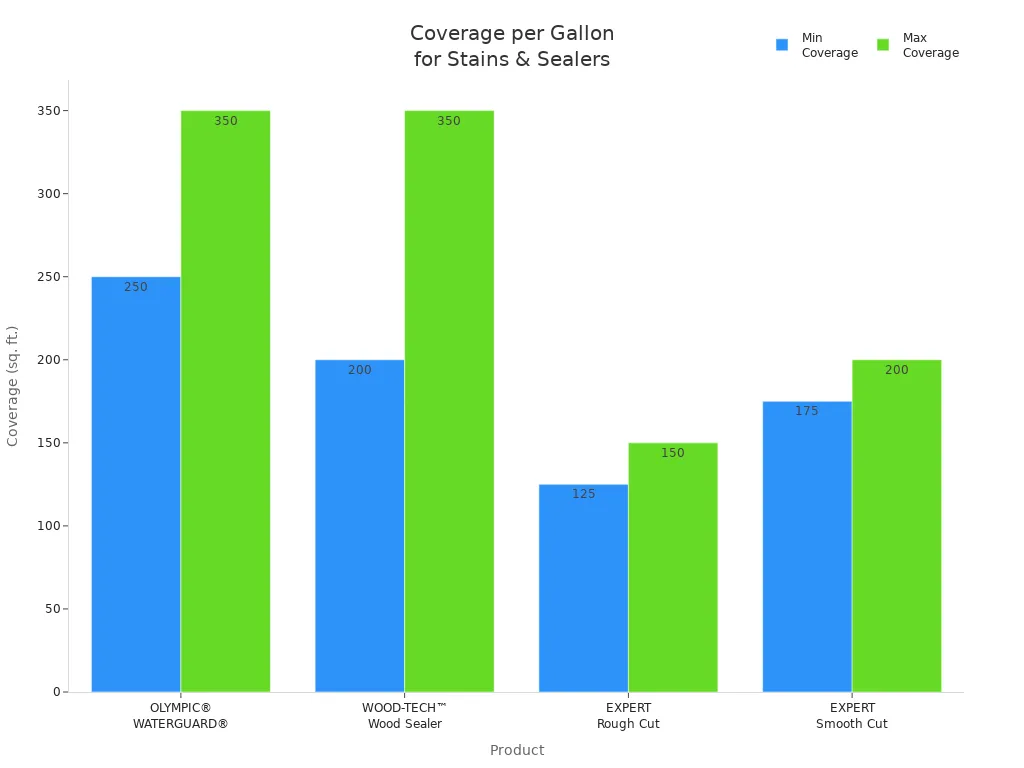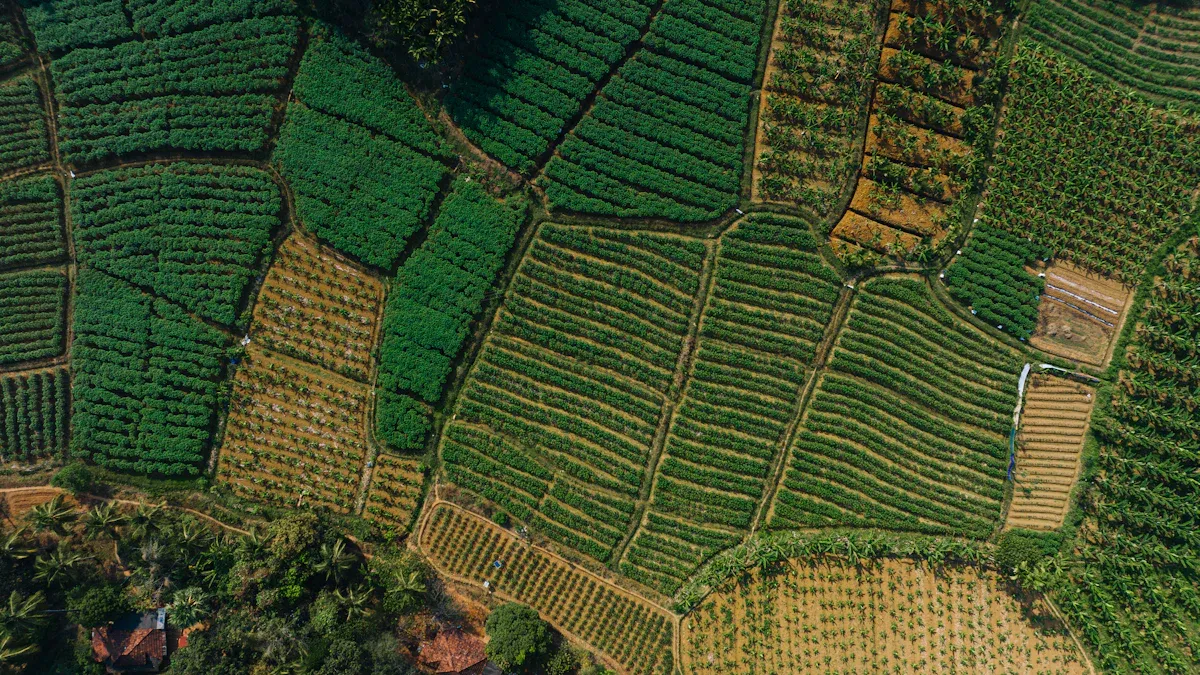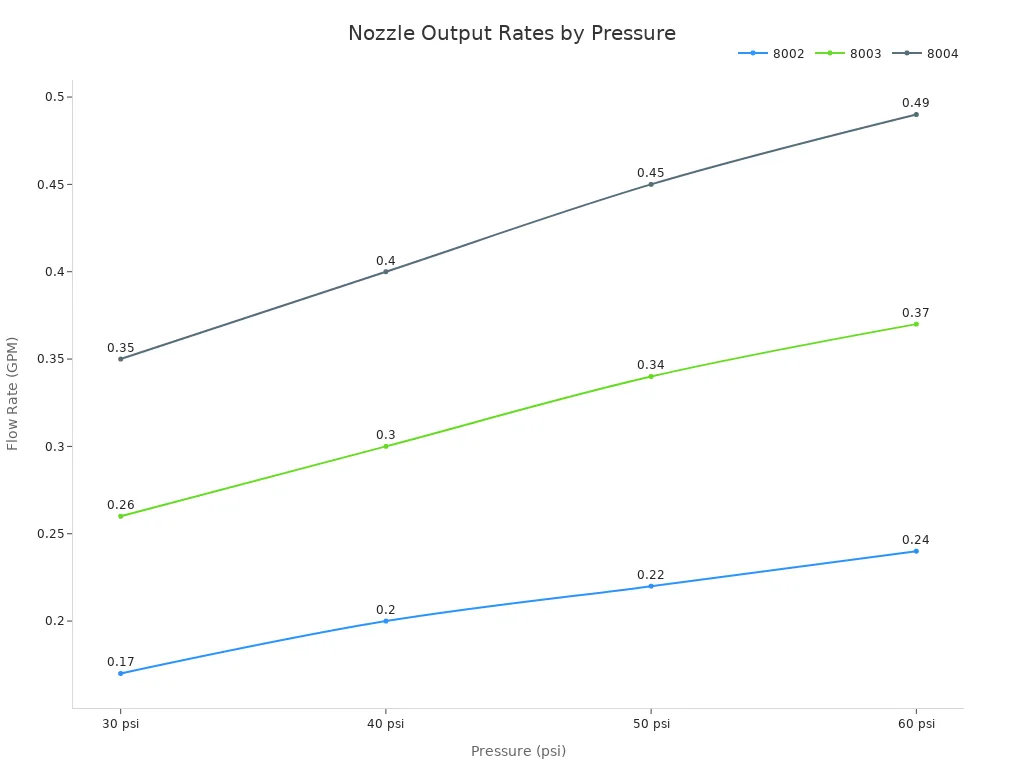You can usually cover about 1,000 square feet with a 1 gallon pump sprayer. This number comes from industry and manufacturer data. It is a good starting point for most projects. Your real coverage might be more or less. Things like nozzle type and spray pattern can change this. The kind of product you use also matters. Some products, when mixed in certain ways, can make one gallon cover over 5,000 square feet.
Key Takeaways
A 1 gallon pump sprayer usually covers about 1,000 square feet. The amount it covers can change. It depends on the nozzle type, spray pattern, surface, and product you use. Picking the right nozzle and walking speed is important. This helps you use the right amount of liquid. It also makes sure you cover everything evenly and do not waste spray. Different surfaces soak up spray in different ways. Smooth surfaces need less liquid. Rough or absorbent surfaces need more liquid. Always read the product labels for coverage rates. Follow safety steps like wearing protective gear. Make sure to calibrate your sprayer. Take care of your sprayer by cleaning it often. Check the nozzles to keep them working well. This helps stop clogs or leaks.
Pump Sprayer Coverage Factors
When you use a pump sprayer, several factors decide how much area you can cover with one gallon. Understanding these factors helps you get the best results for your project.
Spray Pattern
The spray pattern shapes how the liquid spreads. You can choose from flat fan, full cone, or solid stream nozzles.
Flat fan nozzles give you a wide, even spray. They work well for large areas but wind can move the spray.
Full cone nozzles create a round pattern. This type gives you even coverage in a smaller spot, which is good for targeted spraying.
Solid stream nozzles shoot a narrow, strong stream. You can reach high or far spots, but you may miss some areas if you try to cover a wide space.
The angle of the nozzle also matters. A wider angle covers more ground, but you may lose some control. If you raise the sprayer or use closer nozzles, you get more overlap and better coverage.
Application Rate
The application rate tells you how much liquid you use for each square foot. Most people find that one gallon covers about 1,000 square feet with a pump sprayer. Some users report using two or three gallons for the same area, depending on the nozzle and how fast they move. If you want to use less liquid, you can change the nozzle or walk slower.
Surface Type
The type of surface you spray changes how much area you cover. Smooth surfaces like concrete need less liquid. Rough or absorbent surfaces, such as wood or soil, soak up more. You may need to spray more often or use extra product to get full coverage.
Product Type
Most liquid products, like fertilizers and pesticides, cover about the same area per gallon. For example, many lawn care products and insecticides list 1,000 square feet per gallon on their labels. Some special products, like stains or colorants, may have different coverage, but most work the same way in a pump sprayer.
Tip: Always check the label on your product. It tells you the best rate and helps you avoid waste.
Pump Sprayer Coverage
When you use a 1 gallon pump sprayer, you want to know how much area you can treat. The answer depends on what you spray and how you use the sprayer. Most people find that 1 gallon covers 1,000 sq ft, but this can change with different products and surfaces. Below, you will see how coverage changes for lawns, gardens, pesticides, herbicides, stains, and sealers.
Lawn and Garden
You often use a pump sprayer for lawns and gardens. Most users report that 1 gallon covers 1,000 sq ft. Some people cover more or less, depending on walking speed and sprayer type. For example, a battery-powered sprayer may help you cover the same area faster than a hand-pumped one. If you walk slowly or overlap your spray, you might use more liquid for the same space.
Note: If you need to treat 4,000 sq ft, you will likely need about 4 gallons of mixed product.
Here is a quick look at coverage for different sprayer types:
Sprayer Type | Coverage per Gallon (sq ft) | Notes |
Hand can / spot sprayer | Just under 1,000 | Good for small lawns and gardens |
Battery-powered backpack | 600 to 1,000 | Faster, but depends on nozzle and speed |
Hand can (fast walking) | About 1,600 | Less overlap, faster pace |
Chemlawn (pro nozzle) | ~1,700 | Professional use, wide swath |
If you want to cover 4,000 sq ft, you should plan for 4 gallons, but adjust if you walk faster or use a wider spray.
Pesticides and Herbicides
When you apply pesticides or herbicides, you need to follow label instructions. Most labels say that 1 gallon covers 1,000 sq ft. This helps you avoid over-applying chemicals. If you have a 4,000 sq ft yard, you will need about 4 gallons of spray mix.
Tip: Always calibrate your sprayer before you start. Spray water on a paved area to see how much you use for 1,000 sq ft. This helps you use the right amount for 4,000 sq ft.
Safety is important when you use chemicals. Here are some key steps:
Wear gloves, goggles, and long sleeves.
Check the wind before spraying. Avoid spraying if wind is over 5 mph.
Clean your sprayer after each use.
Walk at a steady pace for even coverage.
Inspect your sprayer for leaks or clogs.
You can see that 1 gallon covers 1,000 sq ft for most products. For a large area like 4,000 sq ft, you will need to refill your sprayer several times.
Stains and Sealers
Stains and sealers do not cover as much area as water-based sprays. The surface type matters a lot. Rough wood soaks up more product than smooth wood or concrete. Here is a table to help you estimate coverage:
Surface/Product | Coverage per Gallon (sq ft) |
Rough Cut Lumber | 125 - 150 |
Smooth Cut Lumber | 175 - 200 |
OLYMPIC® WATERGUARD® Transparent Wood Stain + Sealer | 250 - 350 |
WOOD-TECH™ Wood Sealer and Stain | 200 - 350 |
EXPERT Semi-Transparent (Rough Cut) | 125 - 150 |
EXPERT Semi-Transparent (Smooth Cut) | 175 - 200 |
If you plan to stain a deck or fence that is 4,000 sq ft, you will need much more product. For rough wood, you may need up to 32 gallons. For smooth wood, you may need about 20 gallons. Always check the product label for the best estimate.
Note: Coverage for stains and sealers is much lower than for lawn or garden sprays. Plan your project and buy enough product for your 4,000 sq ft area.
Quick Reference Table
Application Type | Typical Coverage per Gallon (sq ft) | 4,000 sq ft Area: Gallons Needed |
Lawn/Garden Sprays | 1,000 | 4 |
Pesticides/Herbicides | 1,000 | 4 |
Stains (Rough Wood) | 125 - 150 | 27 - 32 |
Stains (Smooth Wood) | 175 - 200 | 20 - 23 |
Concrete Sealers | 200 - 350 | 12 - 20 |
You can see that 1 gallon covers 1,000 sq ft for most lawn and garden uses, but much less for stains and sealers. Always measure your area and check your product label before you start. This helps you avoid running out of product or over-applying.
Calculate Coverage
Nozzle Output
You need to know how much liquid your sprayer nozzle puts out. This is called the nozzle output. Different nozzles have different flow rates. For example, a flat-fan nozzle labeled 8002 can spray between 0.17 and 0.24 gallons per minute, depending on the pressure. Other nozzles, like the 8003 or 8004, spray even more. You can see the differences in this table:
Nozzle Model | Pressure (psi) | Flow Rate (GPM) |
8002 | 30 | 0.17 |
8002 | 40 | 0.20 |
8002 | 50 | 0.22 |
8002 | 60 | 0.24 |
8003 | 30 | 0.26 |
8003 | 40 | 0.30 |
8003 | 50 | 0.34 |
8003 | 60 | 0.37 |
8004 | 30 | 0.35 |
8004 | 40 | 0.40 |
8004 | 50 | 0.45 |
8004 | 60 | 0.49 |
To measure your nozzle output, fill your sprayer with water. Spray into a container for one minute. Measure the ounces collected. Divide by 128 to get gallons per minute.
Tip: Always check that all nozzles spray the same amount. Replace any nozzle that is off by more than 10%.
Walking Speed
Your walking speed changes how much area you cover with each gallon. If you walk faster, you spray less liquid per square foot. If you walk slower, you use more liquid in the same area. To find your speed, walk a set distance and time yourself. Try to keep the same pace when you spray. This helps you get even coverage.
Two people can use the same sprayer and cover 1,000 square feet. The faster walker uses about 1 gallon. The slower walker may need up to 1.75 gallons for the same area.
Always calibrate your sprayer to match your own walking speed.
Calculation Steps
You can estimate your coverage by following these steps:
Measure nozzle output. Spray into a container for 1 minute. Record ounces, then divide by 128 for gallons per minute.
Find your walking speed. Walk a known distance and time yourself. Divide distance by time for feet per minute.
Measure spray width. This is the width of the spray pattern in feet.
Calculate area covered per minute: walking speed (ft/min) × spray width (ft).
Estimate how much area you can cover with one gallon. Divide 1 gallon by your nozzle output per minute, then multiply by the area you cover per minute.
Note: Recalibrate if you change nozzles, pressure, or walking speed. This keeps your application accurate.
Maximize Pump Sprayer Efficiency
Even Application
You want your pump sprayer to give an even coat. Calibrate your sprayer before you use it. Mark a test spot and spray at your normal pace. Measure how much liquid you use on the test area. This helps you change your walking speed or nozzle height if needed. Keep the nozzle at the same height and use steady pressure. Overlap your spray a little so you do not miss spots. Always read and follow the label for mixing and applying. Using the right amount of water keeps the sprayer from clogging and gives good coverage.
Tip: Try spraying with water first. This lets you practice and find problems before using chemicals.
Reduce Waste
Reducing waste saves money and helps the environment. Using too much product can hurt plants or pollute water. Using too little leaves weeds or bugs behind. You can avoid these mistakes by doing a few things:
Calibrate your sprayer with the area method or 1/128th-acre method.
Use adjustable nozzles to match your spray to the job.
Walk at the same speed and keep the nozzle at the same height.
Follow the label for mixing and how much to use.
Wear gloves, goggles, and other safety gear when spraying and cleaning.
Clean and check your sprayer often to stop leaks and clogs. This helps you spray evenly and not waste product.
Maintenance
Taking care of your pump sprayer makes it last longer. After you finish, empty the tank and rinse it with clean water. Run water through the hose and nozzle to clear out leftover product. If you used chemicals, wash the sprayer with mild soap and rinse well. Take off the nozzle and filters and clean them to stop clogs. Put oil on seals and moving parts to keep them working. Store your sprayer in a cool, dry place away from sun and heat. Check hoses, seals, and nozzles for cracks or leaks before each use. Replace any broken parts right away.
Note: Good care helps your sprayer work well and saves you from repairs.
You can expect a 1 gallon pump sprayer to cover about 1,000 square feet on average. Real-world results may vary. Some products, like Root Growth Stimulant, can stretch coverage to over 5,000 square feet when you use the right dilution and application rate.
Always check the product label for the best guidance.
Adjust your technique based on your surface, spray pattern, and product type.
Use the tips in this guide to get the most from your sprayer.
FAQ
How do you measure the area you need to spray?
You can measure the length and width of your yard or garden. Multiply these numbers to get the total square feet. For odd shapes, break the area into smaller rectangles or squares and add them together.
Can you use the same pump sprayer for different products?
You can use the same sprayer for different products if you clean it well after each use. Rinse the tank, hose, and nozzle with water. For chemicals, use mild soap and rinse again. This prevents mixing and keeps your sprayer working well.
What should you do if your sprayer clogs?
First, stop spraying. Remove the nozzle and check for debris. Rinse the nozzle with water. Use a soft brush if needed. Clean the filter inside the sprayer. Put everything back and test with water before using your product again.
Why does your coverage change with different products?
Different products have unique thickness and absorption rates. Some soak into surfaces more than others. Labels often show how much area each product covers. Always check the label before you start. This helps you plan and avoid running out of product.
















